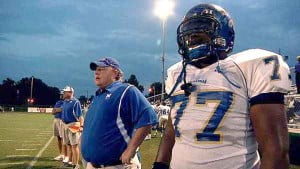Reviewed in this essay: Undefeated, directed by Daniel Lindsay and TJ Martin. Starring Bill Courtney, O.C. Brown, Montrail “Money” Brown. Running Time: 113 minutes.

Early on in Undefeated we witness Bill Courtney – the head coach of the Manassas High School football team – address his players. Courtney, a white local businessman who coaches a predominantly black inner city high school team on his spare time, informs his players that there has been a litany of shootings, arrests, and fights amongst the members of the team. As he mentions each of these cases, questions abound in the audience’s mind: can Courtney use his role as coach to help his players avoid these pitfalls of inner city criminality? Can coaching football be used to impart lessons about dedication, sacrifice, and respect?
Given that Undefeated has been marketed as a feel good story by the powerful Weinstein Company, and that it recently won the Oscar for best documentary, it’s not difficult to guess the answers to these questions. The film thus gives us round after round of inspiring verbiage from coach Courtney as it trains its focus on the personal stories of three particularly notable players. While each player struggles with his demons – bad grades, anger issues, injuries – coach Courtney is always present to work his inspiring blend of folksy moralism on each of them.

If this synopsis sounds familiar to other field good sports narratives of recent years, it’s because it is. No new dramatic ground is really traversed here, despite the promise of a more “real” look into high school football within the documentary form. But certainly the most disappointing aspect of this documentary is its failure to examine the social conditions that make the impoverishment of these high school students possible in the first place. To return to that opening scene: we never do get to find out what happened to all those other students, those victims of gang violence whose cases, once mentioned, are left unexplored. In the directors’ rush to provide us a mushy-headed story of triumph, one suspects that individual cases that could have upended their message were simply ignored. And while the filmmakers enjoy contrasting the derelict houses of the North Memphis neighborhood where the students reside with the palatial McMansions of their white coaches, the shots never coalesce to anything resembling genuine ethnographic critique. The documentarians never, it seems, felt the need to wonder how a society developed in such a way that wealth could be split so unevenly along white and black lines in the first place.
The documentary thus works to reinforce a particularly powerful form of neoliberal ideology: it is hard work and individual initiative that decides all. The inequality of privatized wealth, stratified opportunity, and divided communal life are just passing annoyances, mere trifles, in the individual’s drive to complete himself. The fact that the film is wrapped in the paternalistic guise of moral uplift makes it repression of social structure all the more powerful. In the end, despite the documentary’s promise of gritty, real life representation, it is in fact as unreal as any Hollywood mega-pic. Its fundamental interest thus lies not in its story of triumph, but in the ideological operations that undergrid it.
